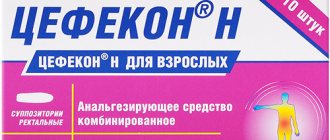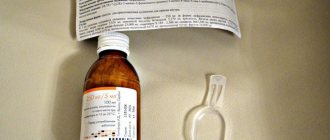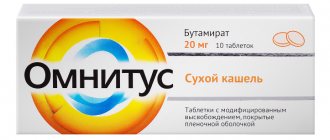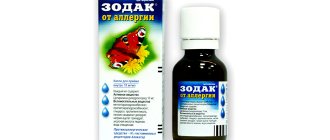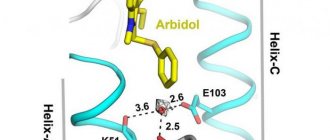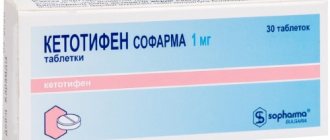Pharmacological properties
Pharmacodynamics
The main effect of paracetamol is antipyretic and analgesic. It affects the centers of thermoregulation and pain, thereby blocking cyclooxygenases in the CNS (central nervous system). Paracetamol does not have a significant anti-inflammatory effect, since cellular peroxidases neutralize its effect in inflamed tissues.
Due to the absence of inhibition of prostaglandin synthesis in the periphery, the drug does not negatively affect the mucous membrane of the gastrointestinal tract and water-salt metabolism (does not cause water and sodium retention in tissues).
Pharmacokinetics
Paracetamol is quickly absorbed from the digestive system. The degree of suction is high. It takes 30 to 60 minutes to achieve maximum plasma concentration. The drug passes through the blood-brain barrier. The bioavailability of paracetamol in newborns and children is similar to that in adults.
Metabolism of paracetamol occurs in the liver. T1/2 is 2–3 hours. During the day, 85–95% of the substance is excreted by the kidneys in the form of sulfates and glucuronides. About 3% of the dose taken is excreted unchanged.
The rate of elimination of the active substance and the total amount excreted in the urine are almost the same in patients of different ages.
Analogs
The occurrence of side effects or allergies to drug components are factors indicating the need to replace the drug. Only the attending physician can select an effective analogue. It is not recommended to do this on your own, as it can harm the general condition of the baby.
Among analogues, the most popular are:
Calpol (RUB 77). The medicine is available in the form of syrup. Prescribed to children from 6 years of age. The basis of this medication is paracetamol (120 mg in 5 ml). The kit includes a special measuring spoon with which you can measure the required amount of suspension.
The medicine is characterized by antipyretic and analgesic effects. Helps lower body temperature and eliminate pain syndromes that occur with viral diseases. Does not have a negative effect on the gastrointestinal mucosa.
- Children's Panadol (58 RUR). The syrup also contains paracetamol. The suspension is characterized by a pleasant taste and aroma. The drug is also available in the form of rectal suppositories. Prescribed from 3 months. Gently and effectively eliminates the symptoms of influenza and ARVI. Used for otitis, rubella, chicken pox.
- Dynafed EX (no information on price). The medicine is available in the form of a powder intended for the preparation of a solution. It is based on paracetamol. Prescribed for fever and pain. The mechanism of action is aimed at blocking COX2 and COX1. The main component affects pain centers and the thermoregulation system.
Efferalgan (from 82 rubles). This drug is available in several forms: suspension, suppositories and effervescent tablets. INN – paracetamol. LS is suitable for both children and adults. Release forms are designed for the age characteristics of buyers.For small patients, a suspension or suppositories are suitable. They contain less of the main component. Eliminates pain and normalizes elevated body temperature. The medicine also relieves other symptoms of acute respiratory infections: aches, fatigue, lethargy, muscle weakness.
If the analogue is chosen incorrectly, the patient’s general condition may worsen. As a result of the lack of necessary treatment, the pathology will progress. Therefore, you should consult a doctor so that he can select the most effective suppository substitute. Replacing Cefekon may be necessary if the components are intolerant or if the child does not like the method of administration. Some children prefer syrups.
Indications for use
Cefekon D is used in children aged 3 months to 12 years with the following diseases and conditions:
- childhood infections, acute respiratory infections (acute respiratory diseases), influenza, post-vaccination reactions and other conditions that are accompanied by elevated body temperature (as an antipyretic);
- toothache and headache, neuralgia, muscle pain, pain from burns and injuries, other types of pain of mild and moderate intensity (as an analgesic).
In infants aged 1 to 3 months, a single dose of Cefekon D is possible to reduce elevated body temperature after vaccination. For other indications, at this age the drug is used strictly as prescribed by the doctor.
Reviews from parents
You can find a lot of positive reviews about the drug Cefekon D; many parents are extremely satisfied with its effect. Moms note the fact that suppositories quickly normalize body temperature (both from colds and from vaccinations) and cope well with pain symptoms. Most consumers praise Cefekon D for its excellent properties - for example, facilitating the process of teething. In addition, parents note the ease of use when it is not possible to give the baby medicine by mouth. Plus - an affordable price and the drug is available without a prescription.
Contraindications
Cefekon D is contraindicated in infants during the neonatal period, as well as in patients with increased individual sensitivity to paracetamol.
The drug is used with caution in the following cases:
- the presence of liver or kidney failure;
- genetic absence of the enzyme glucose-6-phosphate dehydrogenase;
- benign hyperbilirubinemia (in particular, Gilbert's syndrome);
- period of pregnancy and breastfeeding;
- viral hepatitis;
- alcoholism (including alcoholic liver damage);
- simultaneous use of other medications containing paracetamol.
Rules for storing the drug Cefekon in pharmacies and clinics
According to the order of the Ministry of Health and Social Development of the Russian Federation N 706n “On approval of the Rules for the storage of medicines”, Tsefekon N and D suppositories are stored:
- in refrigeration chambers while maintaining the required temperature;
- near analogues and generics;
- in sealed packaging;
- at a humidity of no more than 70%.
Reciting from SanPinN 2.1.7.2790-10, if expired or falsified drugs are detected, they must be disposed of. In a pharmacy, Tsefekon is given heat treatment and then disposed of. Large quantities of illiquid goods are destroyed at special sites of pharmaceutical companies.
Tsefekon N and D must be transported in special refrigerated chambers to maintain proper storage conditions. Carriers are required to have a license and permit to transport drugs. This is regulated by Federal Law N61 “On the Circulation of Medicines” dated April 12, 2010.
Pharmacists and clinic staff are required to ensure proper storage of medications. Failure to promptly dispose of expired medications may result in a fine, while sale and use in hospitals may result in a suspended sentence.
Cefekon D: instructions for use (dosage and method)
Tsefekon D suppositories are used rectally (by insertion into the rectum). It is recommended to administer the suppository after a cleansing enema or spontaneous bowel movement.
The dose of the drug is calculated individually, taking into account the patient’s age and body weight. For children, a single dose is 10–15 mg/kg body weight, the frequency of use is 2–3 times a day (the interval between administrations of suppositories should be at least 4–6 hours). The maximum dose is 60 mg/kg body weight per day.
Estimated single doses of Cefekon D for children aged 1 month to 12 years:
- age 1–3 months, body weight 4–6 kg – one suppository 50 mg;
- age 3–12 months, body weight 7–10 kg – one suppository 100 mg;
- age 1–3 years, body weight 11–16 kg – one or two suppositories 100 mg;
- age 3–10 years, body weight 17–30 kg – one suppository 250 mg;
- age 10–12 years, body weight 31–35 kg – two suppositories of 250 mg.
The duration of therapy is up to 3 days as an antipyretic and up to 5 days as an analgesic. Longer use is possible only after consultation with a specialist.
Composition and release form
Cefekon for children is available only in the form of suppositories. Torpedo-shaped suppositories are creamy white or yellowish white in color. The drug is available in several variations:
- 50 mg;
- 100 mg;
- 250 mg.
The product contains paracetamol as an active substance. This is a well-known non-steroidal anti-inflammatory drug that can eliminate pain and reduce fever.
There is only one auxiliary component - vitepsol. This substance is the basis for the manufacture of suppositories. Therefore, we can say that only paracetamol “works” in Cefekon D suppositories. The lightweight composition allows the medicine to be effective and not injure the child’s body.
Important! The drug begins to act 15-30 minutes after use. The product gradually reduces fever, which helps avoid fainting.
Overdose
In case of an overdose of paracetamol, nausea and vomiting, pale skin, abdominal pain, and anorexia are observed during the first 24 hours. Glucose metabolism is disrupted and metabolic acidosis occurs. Signs of liver intoxication may appear within 12 to 48 hours after taking the drug. In case of severe poisoning, the patient experiences liver failure with encephalopathy, and subsequently coma and death. Possible renal disorders (acute renal failure accompanied by tubular necrosis), pancreatitis and cardiac arrhythmias. In adults, hepatotoxicity of paracetamol occurs with oral administration of 10 g or more.
Treatment depends on the plasma level of paracetamol and the time that has passed since the overdose. After 8-9 hours, it is advisable to administer methionine, after 12 hours - N-acetylcysteine.
special instructions
If the pain persists after 5 days of taking Cefekon D, and the fever does not stop after 3 days of treatment, you should consult a doctor.
It is not recommended to take other paracetamol-containing drugs, as this can lead to an overdose.
When treatment lasts more than 5–7 days, it is necessary to monitor the functional state of the patient’s liver and peripheral blood parameters.
It should be borne in mind that paracetamol distorts the data of some laboratory tests, for example, the amount of uric acid and glucose in the blood plasma.
How to store Cefekon at home
Cefekon N is stored at a temperature not exceeding 25 °C in a place protected from sunlight. The storage temperature of Tsefekon D should be no more than 20 °C. The slight difference in the permissible storage temperature is due to the fact that paracetamol, which is part of Cefekon D, is more susceptible to high temperatures.
Suppositories can be stored in a special medicine cabinet in a dark place, but it is better to place them in a special compartment in the refrigerator door.
When opening the package, it is advisable to indicate the date of opening. But this is optional. If the package is accidentally opened, do not use the drug for more than 24 hours.
Do not store suppositories:
- near heating devices;
- in a place accessible to children;
- in the closet or on the balcony;
- on the windowsill.
Analogs of Cefekon:
- Efferalgan;
- Paracetamol;
- Panadol;
- Tylenol;
- Perfalgan;
- Lupocet;
- Aldorol;
- Ifimol;
- Piaron.
Drug interactions
Ethanol, hepatotoxic drugs and inducers of microsomal liver enzymes (barbiturates, tricyclic antidepressants, phenytoin, phenylbutazone, rifampicin, flumecinol) increase the formation of hydroxylated metabolites of paracetamol and increase the risk of severe intoxication (even in the case of a slight overdose). Inhibitors of microsomal oxidation, in turn, reduce the risk of hepatotoxicity.
Salicylates enhance the negative effect of paracetamol on the kidneys. Paracetamol increases the toxicity of chloramphenicol, reduces the effectiveness of uricosurics and enhances the effect of indirect anticoagulants.
Reviews of Tsefekon D
According to reviews, Cefekon D for children is an effective, affordable and easy-to-use antipyretic and analgesic. It is recommended by more than 93% of users. The drug does not affect the gastrointestinal tract, since it is administered topically rather than orally. It is convenient to administer to children who, due to age or other reasons, cannot take paracetamol in the form of syrup or tablets. Suppositories are available in pharmacies and are inexpensive.
Among the disadvantages, the only possible side effects can be noted, but they also occur very rarely. Also, some mothers complain about difficult-to-remove oil stains remaining on clothes after using Cefekon D suppositories.
Side effects
You need to be careful with Cefekon suppositories, since many children experience side effects after using them. If the child feels unwell after the first use of suppositories, then the course of treatment should be suspended.
Common side effects that are normal:
- nausea;
- diarrhea;
- stomach ache.
It is not normal for a child to start vomiting or become anemic. You should also be wary of signs of allergies: itching, swelling, rashes. The manufacturer does not provide data on overdose, so you need to be careful.
Advice! Use suppositories correctly, carry out all hygiene procedures before administering suppositories and follow the dosage.
